Study on the Parameters of Ice Clouds Based on 1.5 µm Micropulse Polarization Lidar
Abstract
1. Introduction
2. Instruments and Methods
2.1. Instruments
2.2. Method
3. Results and Discussion
4. Conclusions
Supplementary Materials
Author Contributions
Funding
Data Availability Statement
Conflicts of Interest
References
- Gultepe, I.; Isaac, G. Scale effects on averaging of cloud droplet and aerosol number concentrations: Observations and models. J. Clim. 1999, 12, 1268–1279. [Google Scholar] [CrossRef]
- Ramanathan, V.; Crutzen, P.J.; Kiehl, J.; Rosenfeld, D. Aerosols, climate, and the hydrological cycle. Science 2001, 294, 2119–2124. [Google Scholar] [CrossRef] [PubMed]
- Kiehl, J.; Briegleb, B. The relative roles of sulfate aerosols and greenhouse gases in climate forcing. Science 1993, 260, 311–314. [Google Scholar] [CrossRef] [PubMed]
- Koren, I.; Kaufman, Y.J.; Remer, L.A.; Martins, J.V. Measurement of the effect of Amazon smoke on inhibition of cloud formation. Science 2004, 303, 1342–1345. [Google Scholar] [CrossRef]
- Liu, Y.; Jia, R.; Dai, T.; Xie, Y.; Shi, G. A review of aerosol optical properties and radiative effects. J. Meteorol. Res. 2014, 28, 1003–1028. [Google Scholar] [CrossRef]
- Rosenfeld, D.; Lohmann, U.; Raga, G.B.; O’Dowd, C.D.; Kulmala, M.; Fuzzi, S.; Reissell, A.; Andreae, M.O. Flood or drought: How do aerosols affect precipitation? Science 2008, 321, 1309–1313. [Google Scholar] [CrossRef]
- McFarquhar, G.; Ghan, S.; Verlinde, J.; Korolev, A.; Strapp, J.; Schmid, B.; Tomlinson, J.; Wolde, M.; Brooks, S.; Cziczo, D.; et al. Indirect and Semi-Direct Aerosol Campaign: The Impact of Arctic Aerosols on Clouds. Bull. Am. Meteorol. Soc. 2011, 92, 183–201. [Google Scholar] [CrossRef]
- Pruppacher, H.R.; Klett, J.D.; Wang, P.K. Microphysics of clouds and precipitation. Aerosol Sci. Technol. 1998, 28, 381–382. [Google Scholar] [CrossRef]
- Stocker, T.F.; Qin, D.; Plattner, G.-K.; Tignor, M.M.; Allen, S.K.; Boschung, J.; Nauels, A.; Xia, Y.; Bex, V.; Midgley, P.M. Climate Change 2013: The Physical Science Basis. Contribution of Working Group I to the Fifth Assessment Report of IPCC the Intergovernmental Panel on Climate Change; Cambridge University Press: Cambridge, UK, 2014. [Google Scholar]
- Fan, J.; Wang, Y.; Rosenfeld, D.; Liu, X. Review of aerosol–cloud interactions: Mechanisms, significance, and challenges. J. Atmos. Sci. 2016, 73, 4221–4252. [Google Scholar] [CrossRef]
- Gultepe, I.; Rabin, R.; Ware, R.; Pavolonis, M. Chapter Three—Light Snow Precipitation and Effects on Weather and Climate. In Advances in Geophysics; Nielsen, L., Ed.; Elsevier: Amsterdam, The Netherlands, 2016; Volume 57, pp. 147–210. [Google Scholar]
- Kanji, Z.A.; Ladino, L.A.; Wex, H.; Boose, Y.; Burkert-Kohn, M.; Cziczo, D.J.; Krämer, M. Overview of ice nucleating particles. Meteorol. Monogr. 2017, 58, 1.1–1.33. [Google Scholar] [CrossRef]
- Gultepe, I.; Heymsfield, A.J.; Gallagher, M.; Ickes, L.; Baumgardner, D. Ice fog: The current state of knowledge and future challenges. Meteorol. Monogr. 2017, 58, 4.1–4.24. [Google Scholar] [CrossRef]
- Gultepe, I.; Heymsfield, A.; Field, P.; Axisa, D. Ice-phase precipitation. Meteorol. Monogr. 2017, 58, 6.1–6.36. [Google Scholar] [CrossRef]
- Van Diedenhoven, B.; Fridlind, A.M.; Cairns, B.; Ackerman, A.S.J. Variation of ice crystal size, shape, and asymmetry parameter in tops of tropical deep convective clouds. J. Geophys. Res. Atmos. 2014, 119, 11809–11825. [Google Scholar] [CrossRef]
- Khvorostyanov, V.I.; Curry, J.A. The theory of ice nucleation by heterogeneous freezing of deliquescent mixed CCN. Part I: Critical radius, energy, and nucleation rate. J. Atmos. Sci. 2004, 61, 2676–2691. [Google Scholar] [CrossRef]
- Phillips, V.T.; DeMott, P.J.; Andronache, C. An empirical parameterization of heterogeneous ice nucleation for multiple chemical species of aerosol. J. Atmos. Sci. 2008, 65, 2757–2783. [Google Scholar] [CrossRef]
- Diehl, K.; Wurzler, S. Heterogeneous drop freezing in the immersion mode: Model calculations considering soluble and insoluble particles in the drops. J. Atmos. Sci. 2004, 61, 2063–2072. [Google Scholar] [CrossRef]
- Li, R.; Min, Q.L. Impacts of mineral dust on the vertical structure of precipitation. J. Geophys. Res. Atmos. 2010, 115, 09203. [Google Scholar] [CrossRef]
- Niemand, M.; Möhler, O.; Vogel, B.; Vogel, H.; Hoose, C.; Connolly, P.; Klein, H.; Bingemer, H.; DeMott, P.; Skrotzki, J.; et al. A particle-surface-area-based parameterization of immersion freezing on desert dust particles. J. Atmos. Sci. 2012, 69, 3077–3092. [Google Scholar] [CrossRef]
- Creamean, J.M.; Suski, K.J.; Rosenfeld, D.; Cazorla, A.; DeMott, P.J.; Sullivan, R.C.; White, A.B.; Ralph, F.M.; Minnis, P.; Comstock, J.M.; et al. Dust and biological aerosols from the Sahara and Asia influence precipitation in the western US. Science 2013, 339, 1572–1578. [Google Scholar] [CrossRef]
- Jensen, E.J.; Lawson, R.P.; Bergman, J.W.; Pfister, L.; Bui, T.P.; Schmitt, C.G. Physical processes controlling ice concentrations in synoptically forced, midlatitude cirrus. J. Geophys. Res. Atmos. 2013, 118, 5348–5360. [Google Scholar] [CrossRef]
- Meskhidze, N.; Remer, L.; Platnick, S.; Negrón Juárez, R.; Lichtenberger, A.; Aiyyer, A. Exploring the differences in cloud properties observed by the Terra and Aqua MODIS Sensors. Atmos. Chem. Phys. 2009, 9, 3461–3475. [Google Scholar] [CrossRef]
- Ten Hoeve, J.E.; Jacobson, M.Z.; Remer, L.A. Comparing results from a physical model with satellite and in situ observations to determine whether biomass burning aerosols over the Amazon brighten or burn off clouds. J. Geophys. Res. Atmos. 2012, 117, D08203. [Google Scholar] [CrossRef]
- Altaratz, O.; Koren, I.; Remer, L.; Hirsch, E. Cloud invigoration by aerosols—Coupling between microphysics and dynamics. Atmos. Res. 2014, 140, 38–60. [Google Scholar] [CrossRef]
- Jiang, J.H.; Su, H.; Massie, S.T.; Colarco, P.R.; Schoeberl, M.R.; Platnick, S. Aerosol-CO relationship and aerosol effect on ice cloud particle size: Analyses from Aura Microwave Limb Sounder and Aqua Moderate Resolution Imaging Spectroradiometer observations. J. Geophys. Res. Atmos. 2009, 114, D20207. [Google Scholar] [CrossRef]
- Sherwood, S. A microphysical connection among biomass burning, cumulus clouds, and stratospheric moisture. Science 2002, 295, 1272–1275. [Google Scholar] [CrossRef]
- Sherwood, S.C. Aerosols and ice particle size in tropical cumulonimbus. J. Clim. 2002, 15, 1051–1063. [Google Scholar] [CrossRef]
- Chylek, P.; Dubey, M.; Lohmann, U.; Ramanathan, V.; Kaufman, Y.; Lesins, G.; Hudson, J.; Altmann, G.; Olsen, S. Aerosol indirect effect over the Indian Ocean. Geophys. Res. Lett. 2006, 33, L06806. [Google Scholar] [CrossRef]
- Massie, S.T.; Heymsfield, A.; Schmitt, C.; Müller, D.; Seifert, P. Aerosol indirect effects as a function of cloud top pressure. J. Geophys. Res. Atmos. 2007, 112, D06202. [Google Scholar] [CrossRef]
- Wang, Y.; Xin, J.; Li, Z.; Wang, S.; Wang, P.; Hao, W.M.; Nordgren, B.L.; Chen, H.; Wang, L.; Sun, Y. Seasonal variations in aerosol optical properties over China. J. Geophys. Res. Atmos. 2011, 116, D18209. [Google Scholar] [CrossRef]
- Tao, M.; Chen, L.; Su, L.; Tao, J. Satellite observation of regional haze pollution over the North China Plain. J. Geophys. Res. Atmos. 2012, 117, D12203. [Google Scholar] [CrossRef]
- Li, Z.; Xia, X.; Cribb, M.; Mi, W.; Holben, B.; Wang, P.; Chen, H.; Tsay, S.C.; Eck, T.; Zhao, F. Aerosol optical properties and their radiative effects in northern China. J. Geophys. Res. Atmos. 2007, 112, D22S01. [Google Scholar] [CrossRef]
- Lu, Z.; Streets, D.G.; Zhang, Q.; Wang, S.; Carmichael, G.R.; Cheng, Y.F.; Wei, C.; Chin, M.; Diehl, T.; Tan, Q. Sulfur dioxide emissions in China and sulfur trends in East Asia since 2000. Atmos. Chem. Phys. 2010, 10, 6311–6331. [Google Scholar] [CrossRef]
- Yan, L.; Yu-Dong, C.; Shu-Mei, Y. Influence of terrain on air pollution of low layer in Jinan. Shandong Sci. 2004, 17, 40–42. [Google Scholar]
- Yang, L.-X.; Wang, D.-C.; Cheng, S.-H.; Wang, Z.; Zhou, Y.; Zhou, X.-H.; Wang, W.-X. Influence of meteorological conditions and particulate matter on visual range impairment in Jinan, China. Sci. Total Environ. 2007, 383, 164–173. [Google Scholar] [CrossRef]
- Yin, Z.; Wan, Y.; Zhang, Y.; Wang, H. Why super sandstorm 2021 in North China? Natl. Sci. Rev. 2022, 9, nwab165. [Google Scholar] [CrossRef]
- Gu, J.; Du, S.; Han, D.; Hou, L.; Yi, J.; Xu, J.; Liu, G.; Han, B.; Yang, G.; Bai, Z.-P. Major chemical compositions, possible sources, and mass closure analysis of PM2. 5 in Jinan, China. Air Qual. Atmos. Health 2014, 7, 251–262. [Google Scholar] [CrossRef]
- Engelmann, R.; Wandinger, U.; Ansmann, A.; Müller, D.; Žeromskis, E.; Althausen, D.; Wehner, B. Lidar observations of the vertical aerosol flux in the planetary boundary layer. J. Atmos. Ocean. Technol. 2008, 25, 1296–1306. [Google Scholar] [CrossRef]
- Huang, Z.; Huang, J.; Bi, J.; Wang, G.; Wang, W.; Fu, Q.; Li, Z.; Tsay, S.C.; Shi, J. Dust aerosol vertical structure measurements using three MPL lidars during 2008 China-US joint dust field experiment. J. Geophys. Res. Atmos. 2010, 115, D00K15. [Google Scholar]
- Hofer, J.; Ansmann, A.; Althausen, D.; Engelmann, R.; Baars, H.; Fomba, K.W.; Wandinger, U.; Abdullaev, S.F.; Makhmudov, A.N. Optical properties of Central Asian aerosol relevant for spaceborne lidar applications and aerosol typing at 355 and 532 nm. Atmos. Chem. Phys. 2020, 20, 9265–9280. [Google Scholar] [CrossRef]
- Badarinath, K.; Kharol, S.K.; Sharma, A.R. Long-range transport of aerosols from agriculture crop residue burning in Indo-Gangetic Plains—A study using LIDAR, ground measurements and satellite data. J. Atmos. Sol.-Terr. Phys. 2009, 71, 112–120. [Google Scholar] [CrossRef]
- Park, D.-H.; Kim, S.-W.; Kim, M.-H.; Yeo, H.; Park, S.S.; Nishizawa, T.; Shimizu, A.; Kim, C.-H. Impacts of local versus long-range transported aerosols on PM10 concentrations in Seoul, Korea: An estimate based on 11-year PM10 and lidar observations. Sci. Total Environ. 2021, 750, 141739. [Google Scholar] [CrossRef]
- Liang, C.; Wang, C.; Xue, X.; Dou, X.; Chen, T. Meter scale and sub-second resolution coherent Doppler wind lidar and hyperfine. Technology 2022, 9, 10. [Google Scholar] [CrossRef]
- Barbaresco, F.; Thobois, L.; Dolfi-Bouteyre, A.; Jeannin, N.; Wilson, R.K.; Valla, M.; Hallermeyer, A.; Feneyrou, P.; Brion, V.; Besson, L.; et al. Monitoring Wind, Turbulence and Aircraft Wake Vortices by High Resolution RADAR and LIDAR Remote Sensors in all Weather Conditions. Journées Sci. 2015, 81–110. [Google Scholar]
- Mao, F.; Gong, W.; Song, S.; Zhu, Z. Determination of the boundary layer top from lidar backscatter profiles using a Haar wavelet method over Wuhan, China. Opt. Laser Technol. 2013, 49, 343–349. [Google Scholar] [CrossRef]
- Bu, L.; Pan, H.; Kumar, K.R.; Huang, X.; Gao, H.; Qin, Y.; Liu, X.; Kim, D. LIDAR and Millimeter-Wave Cloud RADAR (MWCR) techniques for joint observations of cirrus in Shouxian (32.56°N, 116.78°E), China. J. Atmos. Sol.-Terr. Phys. 2016, 148, 64–73. [Google Scholar] [CrossRef]
- Pal, S.R.; Steinbrecht, W.; Carswell, A.I. Automated method for lidar determination of cloud-base height and vertical extent. Appl. Opt. 1992, 31, 1488–1494. [Google Scholar] [CrossRef]
- Schotland, R.M.; Sassen, K.; Stone, R. Observations by lidar of linear depolarization ratios for hydrometeors. J. Appl. Meteorol. Climatol. 1971, 10, 1011–1017. [Google Scholar] [CrossRef]
- Jimenez, C.; Ansmann, A.; Engelmann, R.; Donovan, D.; Malinka, A.; Seifert, P.; Wiesen, R.; Radenz, M.; Yin, Z.; Bühl, J.; et al. The dual-field-of-view polarization lidar technique: A new concept in monitoring aerosol effects in liquid-water clouds–case studies. Atmos. Chem. Phys. 2020, 20, 15265–15284. [Google Scholar] [CrossRef]
- Holben, B.N.; Eck, T.F.; Slutsker, I.A.; Tanre, D.; Buis, J.; Setzer, A.; Vermote, E.; Reagan, J.A.; Kaufman, Y.; Nakajima, T. AERONET—A federated instrument network and data archive for aerosol characterization. Remote Sens. Environ. 1998, 66, 1–16. [Google Scholar] [CrossRef]
- Fan, Y.; Sun, X.; Huang, H.; Ti, R.; Liu, X. The primary aerosol models and distribution characteristics over China based on the AERONET data. J. Quant. Spectrosc. Radiat. Transf. 2021, 275, 107888. [Google Scholar] [CrossRef]
- Chen, Z.; Schofield, R.; Rayner, P.; Zhang, T.; Liu, C.; Vincent, C.; Fiddes, S.; Ryan, R.G.; Alroe, J.; Ristovski, Z.D. Characterization of aerosols over the Great Barrier Reef: The influence of transported continental sources. Sci. Total Environ. 2019, 690, 426–437. [Google Scholar] [CrossRef] [PubMed]
- Xiang, Y.; Lv, L.; Chai, W.; Zhang, T.; Liu, J.; Liu, W. Using Lidar technology to assess regional air pollution and improve estimates of PM2. 5 transport in the North China Plain. Environ. Res. Lett. 2020, 15, 094071. [Google Scholar] [CrossRef]
- Nehrir, A.R.; Barton-Grimley, R.A.; Kooi, S.A.; Notari, A.; Harper, D.B.; Collins, J.E., Jr.; DiGangi, J.P.; Davis, K.J. Combined Lidar Measurements of Methane, Aerosols, and Planetary Boundary Layer Heights over Urban and Rural Environments with the NASA High Altitude Lidar Observatory. In Proceedings of the AGU Fall Meeting Abstracts, Washington, DC, USA, 10–14 December 2018; p. A43R-3445. [Google Scholar]
- Wu, Y.; Cordero, L.; Gross, B.; Moshary, F.; Ahmed, S. Assessment of CALIPSO attenuated backscatter and aerosol retrievals with a combined ground-based multi-wavelength lidar and sunphotometer measurement. Atmos. Environ. 2014, 84, 44–53. [Google Scholar] [CrossRef]
- Costantino, L.; Bréon, F.M. Analysis of aerosol-cloud interaction from multi-sensor satellite observations. Geophys. Res. Lett. 2010, 37, L11801. [Google Scholar] [CrossRef]
- Chen, T.; Li, Z.; Kahn, R.A.; Zhao, C.; Rosenfeld, D.; Guo, J.; Han, W.; Chen, D. Potential impact of aerosols on convective clouds revealed by Himawari-8 observations over different terrain types in eastern China. Atmos. Chem. Phys. 2021, 21, 6199–6220. [Google Scholar] [CrossRef]
- Wang, C.; Jia, M.; Xia, H.; Wu, Y.; Wei, T.; Shang, X.; Yang, C.; Xue, X.; Dou, X. Relationship analysis of PM 2.5 and boundary layer height using an aerosol and turbulence detection lidar. Atmos. Meas. Tech. 2019, 12, 3303–3315. [Google Scholar] [CrossRef]
- Yu, C.; Qiu, J.; Xia, H.; Dou, X.; Zhang, J.; Pan, J.-W. Compact and lightweight 1.5 μ m lidar with a multi-mode fiber coupling free-running InGaAs/InP single-photon detector. Rev. Sci. Instrum. 2018, 89, 103106. [Google Scholar] [CrossRef]
- Wang, C.; Xia, H.; Shangguan, M.; Wu, Y.; Wang, L.; Zhao, L.; Qiu, J.; Zhang, R. 1.5 μm polarization coherent lidar incorporating time-division multiplexing. Opt. Express 2017, 25, 20663–20674. [Google Scholar] [CrossRef]
- Winker, D.M.; Hunt, W.H.; McGill, M.J. Initial performance assessment of CALIOP. Geophys. Res. Lett. 2007, 34, L19803. [Google Scholar] [CrossRef]
- Winker, D.M.; Vaughan, M.A.; Omar, A.; Hu, Y.; Powell, K.A.; Liu, Z.; Hunt, W.H.; Young, S.A. Overview of the CALIPSO mission and CALIOP data processing algorithms. J. Atmos. Ocean. Technol. 2009, 26, 2310–2323. [Google Scholar] [CrossRef]
- Nowottnick, E.P.; Colarco, P.R.; Welton, E.J.; da Silva, A. Use of the CALIOP vertical feature mask for evaluating global aerosol models. Atmos. Meas. Tech. 2015, 8, 3647–3669. [Google Scholar] [CrossRef]
- Bessho, K.; Date, K.; Hayashi, M.; Ikeda, A.; Imai, T.; Inoue, H.; Kumagai, Y.; Miyakawa, T.; Murata, H.; Ohno, T. An introduction to Himawari-8/9—Japan’s new-generation geostationary meteorological satellites. J. Meteorol. Soc. Japan. Ser. II 2016, 94, 151–183. [Google Scholar] [CrossRef]
- Zhang, Z.; Wu, W.; Fan, M.; Tao, M.; Wei, J.; Jin, J.; Tan, Y.; Wang, Q. Validation of Himawari-8 aerosol optical depth retrievals over China. Atmos. Environ. 2019, 199, 32–44. [Google Scholar] [CrossRef]
- Dee, D.P.; Uppala, S.M.; Simmons, A.J.; Berrisford, P.; Poli, P.; Kobayashi, S.; Andrae, U.; Balmaseda, M.; Balsamo, G.; Bauer, D.P.; et al. The ERA-Interim reanalysis: Configuration and performance of the data assimilation system. Q. J. R. Meteorol. Soc. 2011, 137, 553–597. [Google Scholar] [CrossRef]
- Hersbach, H.; Bell, B.; Berrisford, P.; Hirahara, S.; Horányi, A.; Muñoz-Sabater, J.; Nicolas, J.; Peubey, C.; Radu, R.; Schepers, D. The ERA5 global reanalysis. Q. J. R. Meteorol. Soc. 2020, 146, 1999–2049. [Google Scholar] [CrossRef]
- Platnick, S.; King, M.D.; Ackerman, S.A.; Menzel, W.P.; Baum, B.A.; Riédi, J.C.; Frey, R.A. The MODIS cloud products: Algorithms and examples from Terra. IEEE Trans. Geosci. Remote Sens. 2003, 41, 459–473. [Google Scholar] [CrossRef]
- Draxler, R.R.; Hess, G. An overview of the HYSPLIT_4 modelling system for trajectories. Aust. Meteorol. Mag. 1998, 47, 295–308. [Google Scholar]
- Wang, Y.; Stein, A.F.; Draxler, R.R.; Jesús, D.; Zhang, X. Global sand and dust storms in 2008: Observation and HYSPLIT model verification. Atmos. Environ. 2011, 45, 6368–6381. [Google Scholar] [CrossRef]
- Ansmann, A.; Riebesell, M.; Wandinger, U.; Weitkamp, C.; Voss, E.; Lahmann, W.; Michaelis, W. Combined Raman elastic-backscatter lidar for vertical profiling of moisture, aerosol extinction, backscatter, and lidar ratio. Appl. Phys. B 1992, 55, 18–28. [Google Scholar] [CrossRef]
- Cao, N.; Zhu, C.; Kai, Y.; Yan, P. A method of background noise reduction in lidar data. Applied Physics B 2013, 113, 115–123. [Google Scholar] [CrossRef]
- Fernald, F.G. Analysis of atmospheric lidar observations: Some comments. Appl. Opt. 1984, 23, 652–653. [Google Scholar] [CrossRef] [PubMed]
- Klett, J.D. Stable analytical inversion solution for processing lidar returns. Appl. Opt. 1981, 20, 211–220. [Google Scholar] [CrossRef] [PubMed]
- Bin, Y.; Zusi, M.; Haijiao, L.; Lingbing, B. Study on abrupt signal processing method of atmospheric lidar. Infrared Laser Eng. 2022, 51, 20211117. [Google Scholar]
- Iwasaka, Y. Measurement of Depolarization of Stratospheric Particles by Lidar A Case Study on the Disturbed Stratospheric Aerosol Layer by the Volcanic Eruption of Mt. El Chichon. J. Geomagn. Geoelectr. 1986, 38, 729–740. [Google Scholar] [CrossRef]
- Iwasaka, Y.; Yamato, M.; Imasu, R.; Ono, A. Transport of Asian dust (KOSA) particles; importance of weak KOSA events on the geochemical cycle of soil particles. Tellus B Chem. Phys. Meteorol. 1988, 40, 494–503. [Google Scholar] [CrossRef]
- Seibert, P.; Beyrich, F.; Gryning, S.-E.; Joffre, S.; Rasmussen, A.; Tercier, P. Review and intercomparison of operational methods for the determination of the mixing height. Atmos. Environ. 2000, 34, 1001–1027. [Google Scholar] [CrossRef]
- Ding, A.; Fu, C.; Yang, X.; Sun, J.; Petäjä, T.; Kerminen, V.-M.; Wang, T.; Xie, Y.; Herrmann, E.; Zheng, L. Intense atmospheric pollution modifies weather: A case of mixed biomass burning with fossil fuel combustion pollution in eastern China. Atmos. Chem. Phys. 2013, 13, 10545–10554. [Google Scholar] [CrossRef]
- Zou, J.; Sun, J.; Ding, A.; Wang, M.; Guo, W.; Fu, C. Observation-based estimation of aerosol-induced reduction of planetary boundary layer height. Adv. Atmos. Sci. 2017, 34, 1057–1068. [Google Scholar] [CrossRef]
- Siqi, Y.; Dong, L.; Jiwei, X. Optimization method for planetary boundary layer height retrieval by lidar. Acta Opt. Sin. 2021, 41, 0728002. [Google Scholar] [CrossRef]
- Rocadenbosch, F.; Frasier, S.; Kumar, D.; Vega, D.L.; Gregorio, E.; Sicard, M. Backscatter error bounds for the elastic lidar two-component inversion algorithm. IEEE Trans. Geosci. Remote Sens. 2012, 50, 4791–4803. [Google Scholar] [CrossRef]
- Garratt, J.R. The atmospheric boundary layer. Earth-Sci. Rev. 1994, 37, 89–134. [Google Scholar] [CrossRef]
- Stull, R.B. An Introduction to Boundary Layer Meteorology; Kluwer Academic Publishers: Dordrecht, The Netherlands; Boston, MA, USA; London, UK, 1988; Volume 13, pp. 10–11. [Google Scholar]
- Liu, S.; Liang, X.-Z. Observed diurnal cycle climatology of planetary boundary layer height. J. Clim. 2010, 23, 5790–5809. [Google Scholar] [CrossRef]
- Du, C.; Liu, S.; Yu, X.; Li, X.; Chen, C.; Peng, Y.; Dong, Y.; Dong, Z.; Wang, F. Urban boundary layer height characteristics and relationship with particulate matter mass concentrations in Xi’an, central China. Aerosol Air Qual. Res. 2013, 13, 1598–1607. [Google Scholar] [CrossRef]
- Petäjä, T.; Järvi, L.; Kerminen, V.-M.; Ding, A.; Sun, J.; Nie, W.; Kujansuu, J.; Virkkula, A.; Yang, X.; Fu, C. Enhanced air pollution via aerosol-boundary layer feedback in China. Sci. Rep. 2016, 6, 18998. [Google Scholar] [CrossRef]
- Sakai, T.; Nagai, T.; Zaizen, Y.; Mano, Y. Backscattering linear depolarization ratio measurements of mineral, sea-salt, and ammonium sulfate particles simulated in a laboratory chamber. Appl. Opt. 2010, 49, 4441–4449. [Google Scholar] [CrossRef]
- Liu, Z.; Vaughan, M.; Winker, D.; Kittaka, C.; Getzewich, B.; Kuehn, R.; Omar, A.; Powell, K.; Trepte, C.; Hostetler, C. The CALIPSO lidar cloud and aerosol discrimination: Version 2 algorithm and initial assessment of performance. J. Atmos. Ocean. Technol. 2009, 26, 1198–1213. [Google Scholar] [CrossRef]
- Marsham, J.H.; Parker, D.J.; Grams, C.M.; Johnson, B.T.; Grey, W.M.; Ross, A.N. Observations of mesoscale and boundary-layer scale circulations affecting dust transport and uplift over the Sahara. Atmos. Chem. Phys. 2008, 8, 6979–6993. [Google Scholar] [CrossRef]
- Omar, A.; Winker, D.; Tackett, J.; Giles, D.; Kar, J.; Liu, Z.; Vaughan, M.; Powell, K.; Trepte, C. CALIOP and AERONET aerosol optical depth comparisons: One size fits none. J. Geophys. Res. Atmos. 2013, 118, 4748–4766. [Google Scholar] [CrossRef]
- Omar, A.H.; Winker, D.M.; Vaughan, M.A.; Hu, Y.; Trepte, C.R.; Ferrare, R.A.; Lee, K.-P.; Hostetler, C.A.; Kittaka, C.; Rogers, R.R.; et al. The CALIPSO automated aerosol classification and lidar ratio selection algorithm. J. Atmos. Ocean. Technol. 2009, 26, 1994–2014. [Google Scholar] [CrossRef]
- Schuster, G.L.; Vaughan, M.; MacDonnell, D.; Su, W.; Winker, D.; Dubovik, O.; Lapyonok, T.; Trepte, C. Comparison of CALIPSO aerosol optical depth retrievals to AERONET measurements, and a climatology for the lidar ratio of dust. Atmos. Chem. Phys. 2012, 12, 7431–7452. [Google Scholar] [CrossRef]
- Burton, S.; Ferrare, R.; Vaughan, M.; Omar, A.; Rogers, R.; Hostetler, C.; Hair, J. Aerosol classification from airborne HSRL and comparisons with the CALIPSO vertical feature mask. Atmos. Meas. Tech. 2013, 6, 1397–1412. [Google Scholar] [CrossRef]
- Papagiannopoulos, N.; Mona, L.; Alados-Arboledas, L.; Amiridis, V.; Baars, H.; Binietoglou, I.; Bortoli, D.; D’Amico, G.; Giunta, A.; Guerrero-Rascado, J.L. CALIPSO climatological products: Evaluation and suggestions from EARLINET. Atmos. Chem. Phys. 2016, 16, 2341–2357. [Google Scholar] [CrossRef]
- Mona, L.; Pappalardo, G.; Amodeo, A.; D’Amico, G.; Madonna, F.; Boselli, A.; Giunta, A.; Russo, F.; Cuomo, V. One year of CNR-IMAA multi-wavelength Raman lidar measurements in coincidence with CALIPSO overpasses: Level 1 products comparison. Atmos. Chem. Phys. 2009, 9, 7213–7228. [Google Scholar] [CrossRef]
- Krämer, M.; Rolf, C.; Spelten, N.; Afchine, A.; Fahey, D.; Jensen, E.; Khaykin, S.; Kuhn, T.; Lawson, P.; Lykov, A.; et al. A microphysics guide to cirrus–Part 2: Climatologies of clouds and humidity from observations. Atmos. Chem. Phys. 2020, 20, 12569–12608. [Google Scholar] [CrossRef]
- Ge, J.; Zheng, C.; Xie, H.; Xin, Y.; Huang, J.; Fu, Q. Midlatitude cirrus clouds at the SACOL site: Macrophysical properties and large-scale atmospheric states. J. Geophys. Res. Atmos. 2018, 123, 2256–2271. [Google Scholar] [CrossRef]
- Heymsfield, A.J.; Krämer, M.; Luebke, A.; Brown, P.; Cziczo, D.J.; Franklin, C.; Lawson, P.; Lohmann, U.; McFarquhar, G.; Ulanowski, Z. Cirrus clouds. Meteorol. Monogr. 2017, 58, 2.1–2.26. [Google Scholar] [CrossRef]
- Sassen, K. The polarization lidar technique for cloud research: A review and current assessment. Bull. Am. Meteorol. Soc. 1991, 72, 1848–1866. [Google Scholar] [CrossRef]
- Thomas, L.; Cartwright, J.; Wareing, D.P. Lidar observations of the horizontal orientation of ice crystals in cirrus clouds. Tellus B 1990, 42, 211–216. [Google Scholar] [CrossRef]
- Gong, J.; Zeng, X.; Wu, D.L.; Li, X. Diurnal variation of tropical ice cloud microphysics: Evidence from Global Precipitation Measurement Microwave Imager polarimetric measurements. Geophys. Res. Lett. 2018, 45, 1185–1193. [Google Scholar] [CrossRef]
- Schmidt, J.; Wandinger, U.; Malinka, A. Dual-field-of-view Raman lidar measurements for the retrieval of cloud microphysical properties. Appl. Opt. 2013, 52, 2235–2247. [Google Scholar] [CrossRef]
- Xie, J.; Huang, X.; Bu, L.; Zhang, H.; Mustafa, F.; Chu, C. Detection of Water Cloud Microphysical Properties Using Multi-scattering Polarization Lidar. Curr. Opt. Photonics 2020, 4, 174–185. [Google Scholar]
- Peng, L.; Yi, F.; Liu, F.; Yin, Z.; He, Y. Optical properties of aerosol and cloud particles measured by a single-line-extracted pure rotational Raman lidar. Opt. Express 2021, 29, 21947–21964. [Google Scholar] [CrossRef] [PubMed]
- Huang, Z.; Nee, J.-B.; Chiang, C.-W.; Zhang, S.; Jin, H.; Wang, W.; Zhou, T. Real-Time Observations of Dust–Cloud Interactions Based on Polarization and Raman Lidar Measurements. Remote Sens. 2018, 10, 1017. [Google Scholar] [CrossRef]
- Wu, S.; Song, X.; Liu, B.; Dai, G.; Liu, J.; Zhang, K.; Qin, S.; Hua, D.; Gao, F.; Liu, L. Mobile multi-wavelength polarization Raman lidar for water vapor, cloud and aerosol measurement. Opt. Express 2015, 23, 33870–33892. [Google Scholar] [CrossRef]
- Wang, Z.; Borovoi, A.; Konoshonkin, A.; Kustova, N.; Wang, B.; Wu, D.; Liu, D.; Xie, C.; Wang, Y. The polarization characteristics of cirrus cloud using lidar and radar in Hefei. In Proceedings of the 26th International Symposium on Atmospheric and Ocean Optics, Atmospheric Physics, Moscow, Russia, 6–10 July 2020; pp. 1131–1136. [Google Scholar]
- Liu, Y.; Hua, S.; Jia, R.; Huang, J. Effect of aerosols on the ice cloud properties over the Tibetan Plateau. J. Geophys. Res. Atmos. 2019, 124, 9594–9608. [Google Scholar] [CrossRef]
- Pan, H.; Wang, M.; Kumar, K.R.; Lu, H.; Mamtimin, A.; Huo, W.; Yang, X.; Yang, F.; Zhou, C. Seasonal and vertical distributions of aerosol type extinction coefficients with an emphasis on the impact of dust aerosol on the microphysical properties of cirrus over the Taklimakan Desert in Northwest China. Atmos. Environ. 2019, 203, 216–227. [Google Scholar] [CrossRef]
- Cziczo, D.J.; Froyd, K.D.; Hoose, C.; Jensen, E.J.; Diao, M.; Zondlo, M.A.; Smith, J.B.; Twohy, C.H.; Murphy, D.M. Clarifying the dominant sources and mechanisms of cirrus cloud formation. Science 2013, 340, 1320–1324. [Google Scholar] [CrossRef]
- Kuebbeler, M.; Lohmann, U.; Hendricks, J.; Kärcher, B. Dust ice nuclei effects on cirrus clouds. Atmos. Chem. Phys. 2014, 14, 3027–3046. [Google Scholar] [CrossRef]
- Avramov, A.; Harrington, J.Y. Influence of parameterized ice habit on simulated mixed phase Arctic clouds. J. Geophys. Res. Atmos. 2010, 115, D03205. [Google Scholar] [CrossRef]
- Morrison, H.; De Boer, G.; Feingold, G.; Harrington, J.; Shupe, M.D.; Sulia, K. Resilience of persistent Arctic mixed-phase clouds. Nat. Geosci. 2012, 5, 11–17. [Google Scholar] [CrossRef]
- Okamoto, H.; Sato, K.; Borovoi, A.; Ishimoto, H.; Masuda, K.; Konoshonkin, A.; Kustova, N. Interpretation of lidar ratio and depolarization ratio of ice clouds using spaceborne high-spectral-resolution polarization lidar. Opt. Express 2019, 27, 36587–36600. [Google Scholar] [CrossRef]
- Konoshonkin, A.; Borovoi, A.; Kustova, N.; Reichardt, J. Power laws for backscattering by ice crystals of cirrus clouds. Opt. Express 2017, 25, 22341–22346. [Google Scholar] [CrossRef]
- Chen, W.-N.; Chiang, C.-W.; Nee, J.-B. Lidar ratio and depolarization ratio for cirrus clouds. Appl. Opt. 2002, 41, 6470–6476. [Google Scholar] [CrossRef]
- Yang, P.; Hu, Y.X.; Winker, D.M.; Zhao, J.; Hostetler, C.A.; Poole, L.; Baum, B.A.; Mishchenko, M.I.; Reichardt, J. Enhanced lidar backscattering by quasi-horizontally oriented ice crystal plates in cirrus clouds. J. Quant. Spectrosc. Radiat. Transf. 2003, 79, 1139–1157. [Google Scholar] [CrossRef]
- Borovoi, A.; Konoshonkin, A.; Kustova, N.; Okamoto, H. Backscattering Mueller matrix for quasi-horizontally oriented ice plates of cirrus clouds: Application to CALIPSO signals. Opt. Express 2012, 20, 28222–28233. [Google Scholar] [CrossRef]
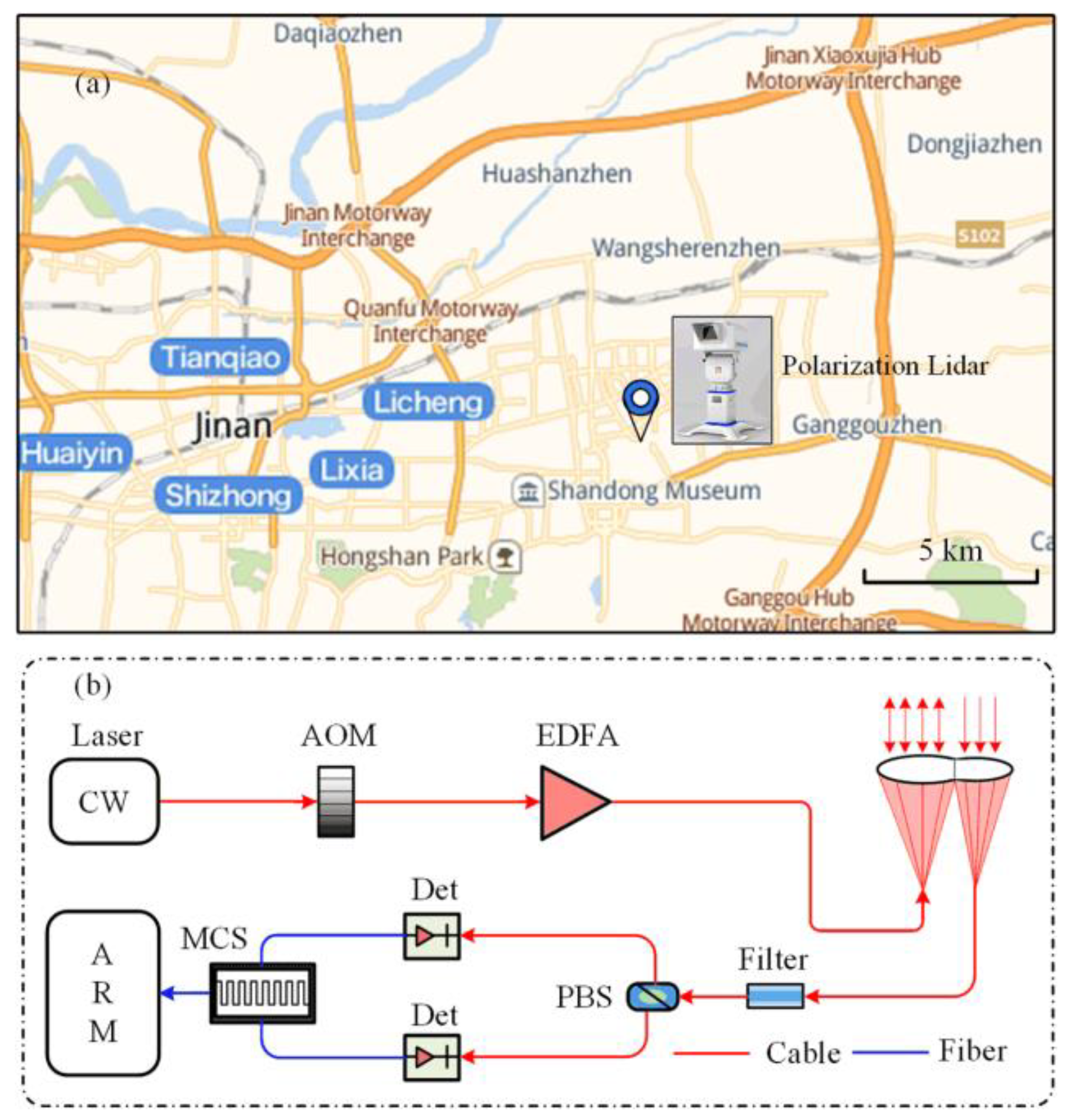
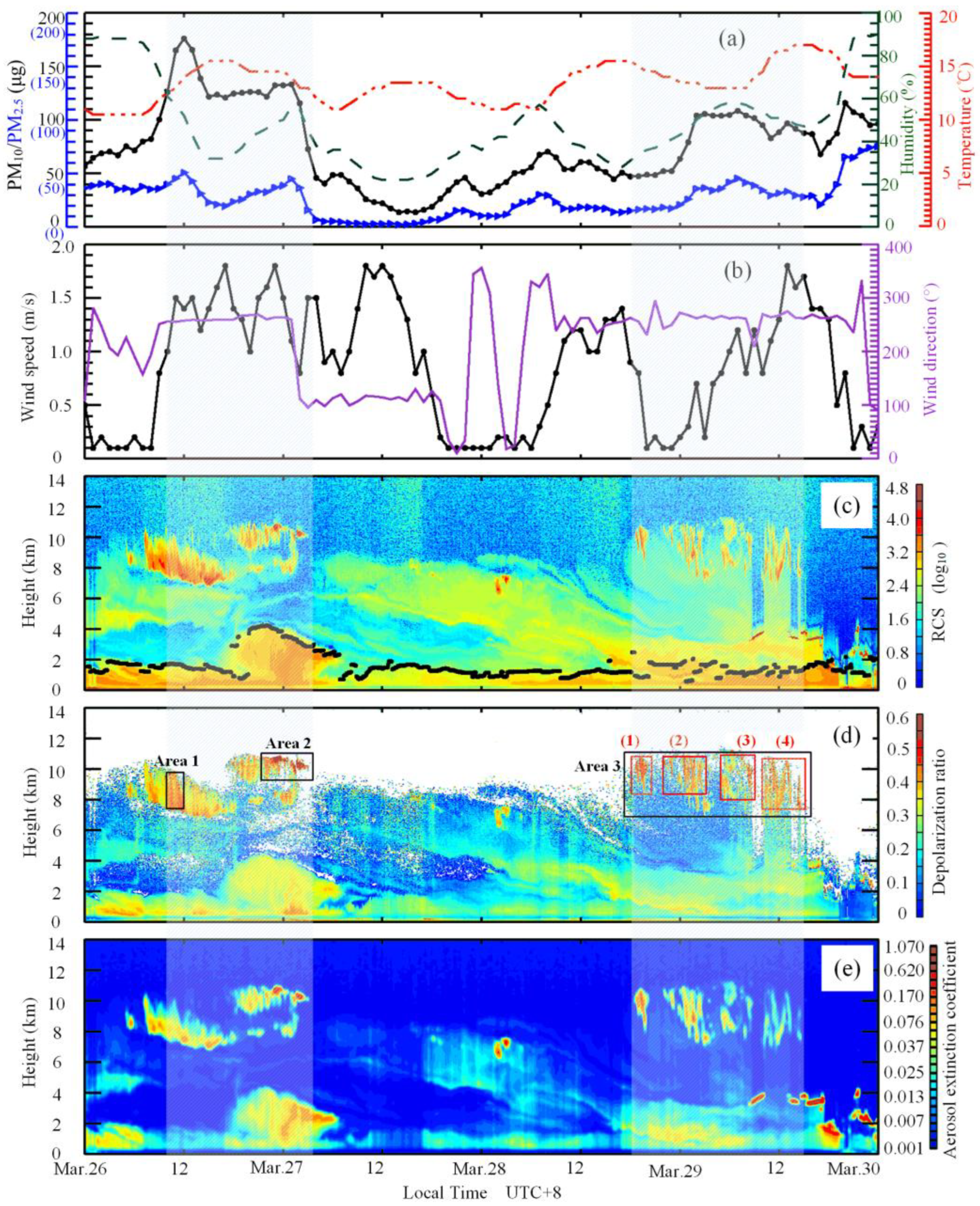
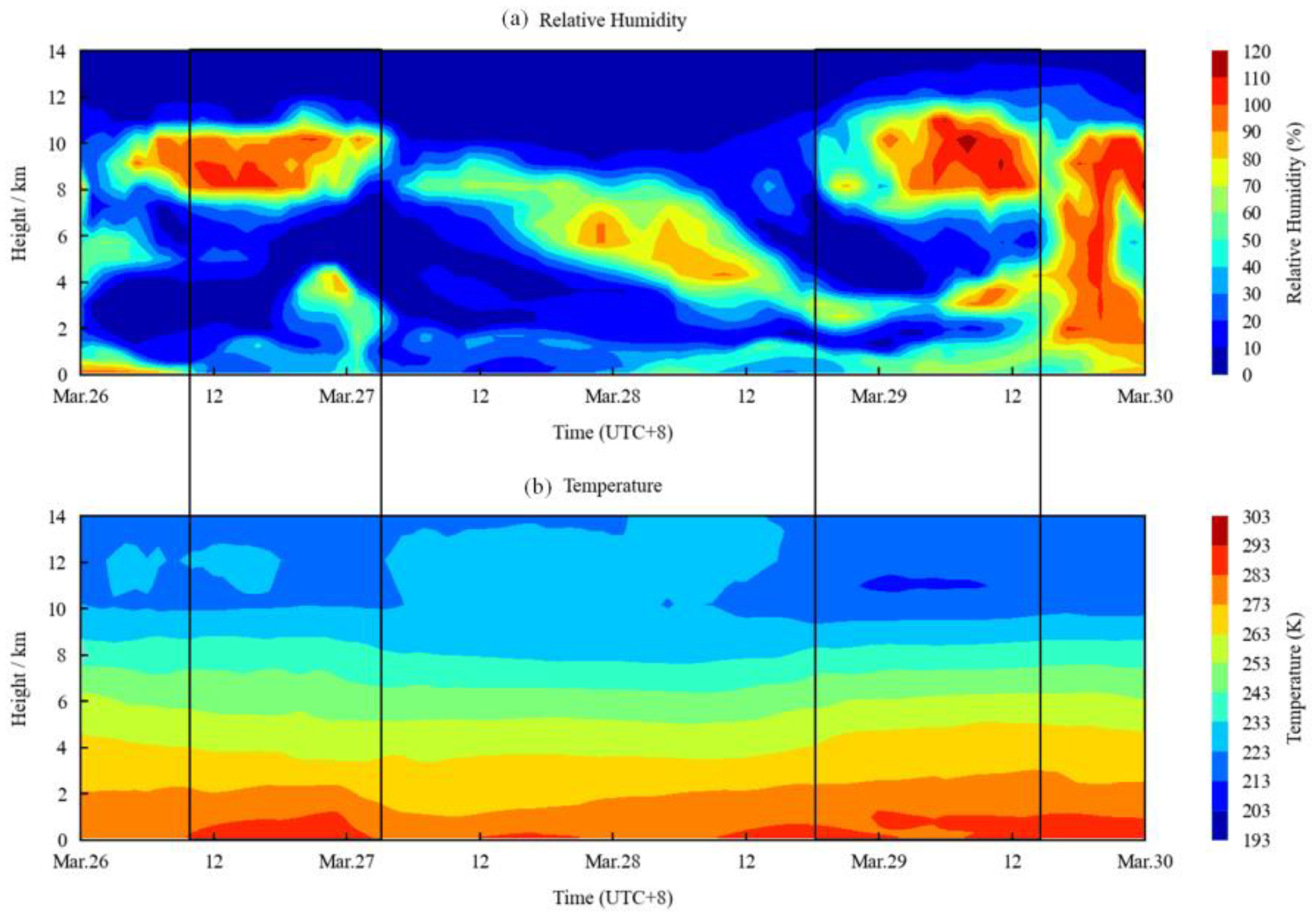
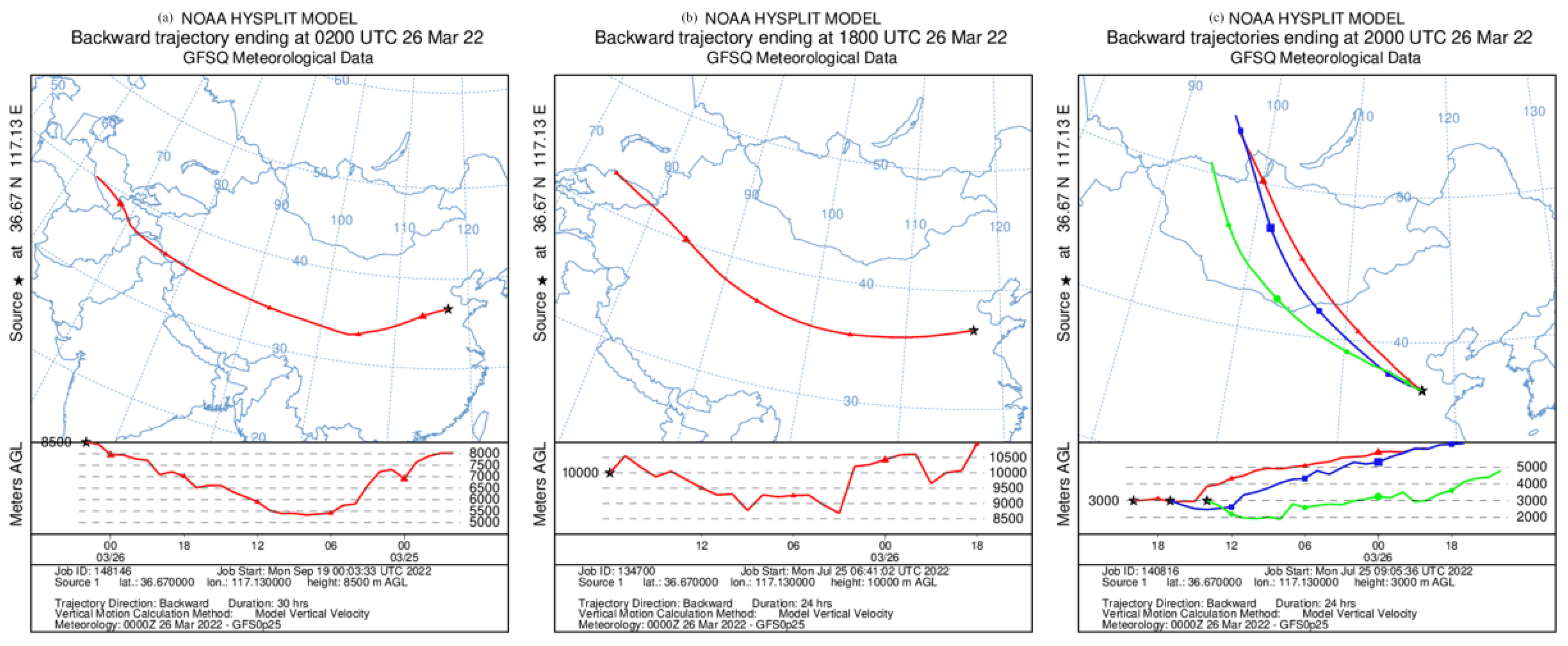
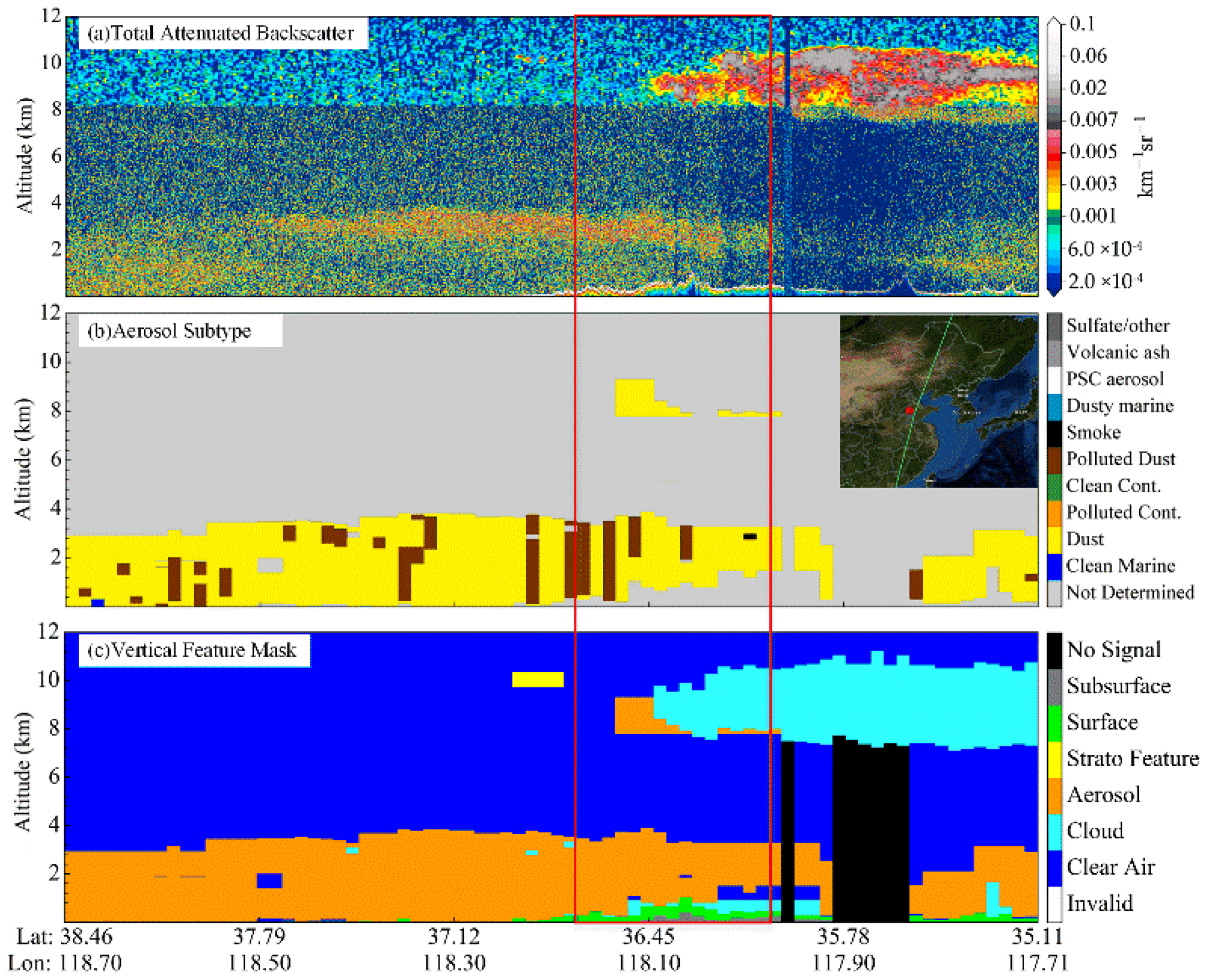


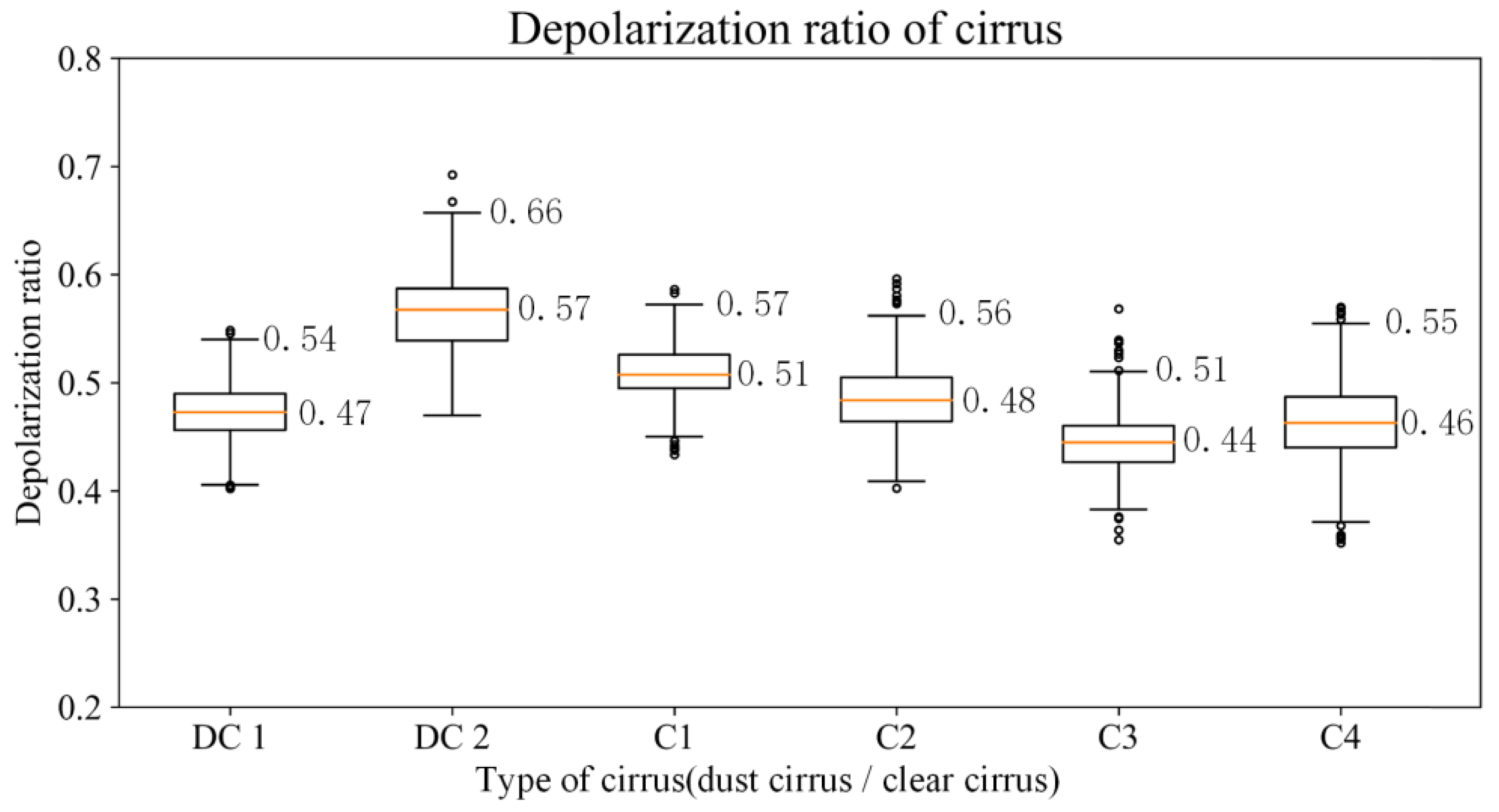
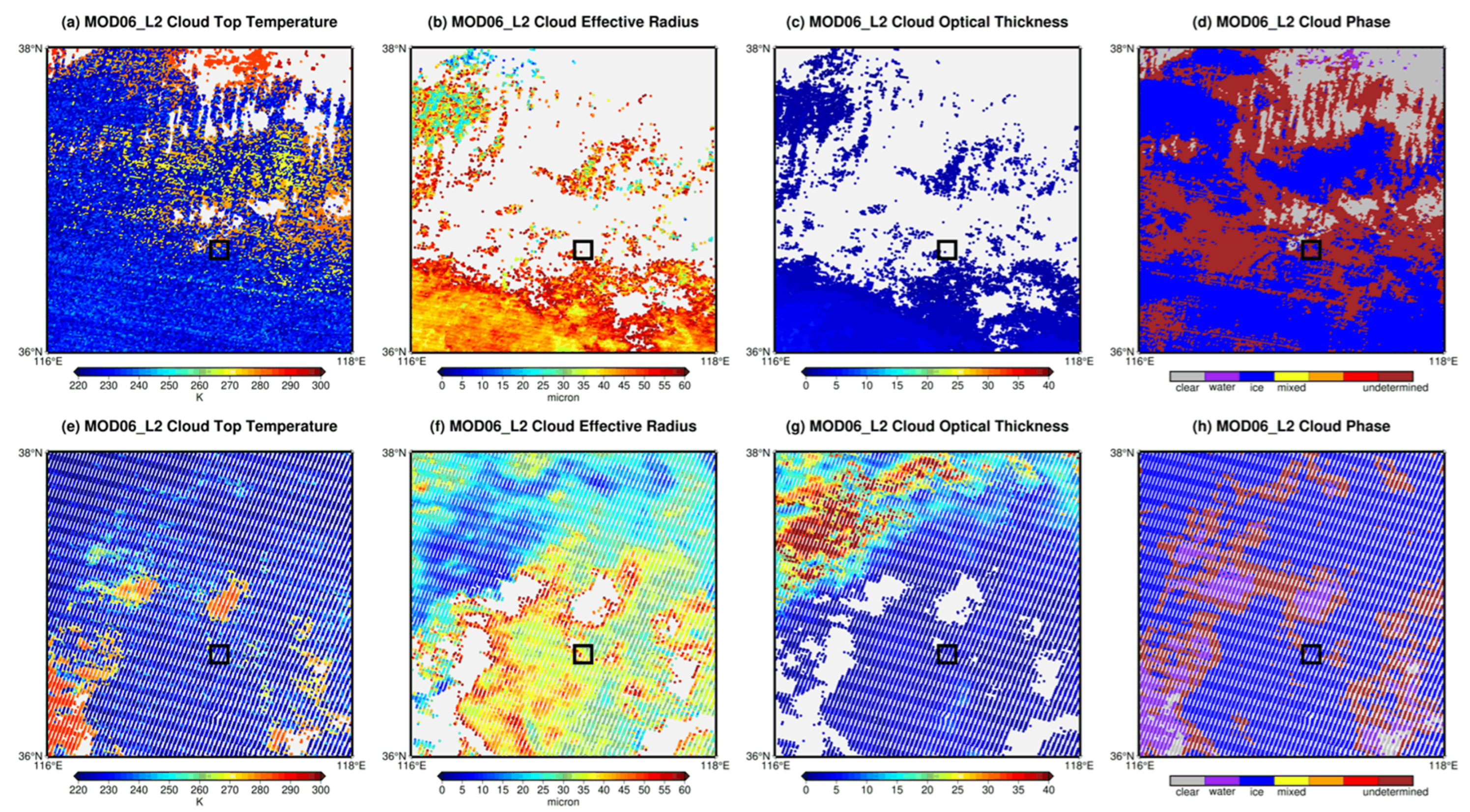
| Parameter | Value |
|---|---|
| Wavelength | 1.5 µm |
| Pulse duration | 100 ns |
| Pulse energy | 70 µJ |
| Diameter of collimator | 80 mm |
| Diameter of telescope | 70 mm |
| Spatial resolution | 30 m |
| Temporal resolution | 1 s |
| Typical detection distance | 15 km |
| Detector quantum efficiency | 13% |
| Dark noise counts | 2500 cps |
| Fiber filter bandwidth (FWHM) | 0.3 nm |
| Polarization ratio of the PBS | 20 dB |
Publisher’s Note: MDPI stays neutral with regard to jurisdictional claims in published maps and institutional affiliations. |
© 2022 by the authors. Licensee MDPI, Basel, Switzerland. This article is an open access article distributed under the terms and conditions of the Creative Commons Attribution (CC BY) license (https://creativecommons.org/licenses/by/4.0/).
Share and Cite
Li, Y.; Wang, C.; Xue, X.; Wang, Y.; Shang, X.; Jia, M.; Chen, T. Study on the Parameters of Ice Clouds Based on 1.5 µm Micropulse Polarization Lidar. Remote Sens. 2022, 14, 5162. https://doi.org/10.3390/rs14205162
Li Y, Wang C, Xue X, Wang Y, Shang X, Jia M, Chen T. Study on the Parameters of Ice Clouds Based on 1.5 µm Micropulse Polarization Lidar. Remote Sensing. 2022; 14(20):5162. https://doi.org/10.3390/rs14205162
Chicago/Turabian StyleLi, Yudie, Chong Wang, Xianghui Xue, Yu Wang, Xiang Shang, Mingjiao Jia, and Tingdi Chen. 2022. "Study on the Parameters of Ice Clouds Based on 1.5 µm Micropulse Polarization Lidar" Remote Sensing 14, no. 20: 5162. https://doi.org/10.3390/rs14205162
APA StyleLi, Y., Wang, C., Xue, X., Wang, Y., Shang, X., Jia, M., & Chen, T. (2022). Study on the Parameters of Ice Clouds Based on 1.5 µm Micropulse Polarization Lidar. Remote Sensing, 14(20), 5162. https://doi.org/10.3390/rs14205162






